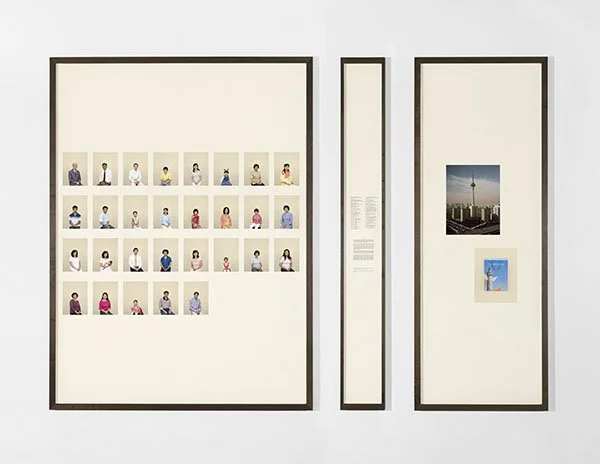Philippe Parreno, Anywhere out of the world, Pinault Collection 2022
text by Perry Shimon
The development of art as a category in Western thought has historically unfolded alongside shifting regimes of power. The Pinault Collection in Paris, housed in the historic Bourse de Commerce building, embodies three centuries of such shifts, providing a palimpsest of ideological progression. Built in the 1760s as a circular grain hall, its form symbolized the monarchy’s role in securing bread supplies and maintaining social order. In the 19th century, it was transformed into the Commodities Exchange, trading sugar, coffee, cocoa, and other goods, capped with an iron-and-glass dome, and encircled by murals romanticizing France’s colonial ambitions—while simultaneously obscuring histories of dispossession, slavery, and genocide. By the late 20th century, the building’s economic function had faded, and in the 21st century it reemerged as a cultural landmark under the Pinault Collection, marking the shift from mercantile and industrial power to finance and cultural capital.
Architect Tadao Ando was commissioned to erect a massive concrete silo in the rotunda, the most ubiquitous material of capitalist infrastructure. Within, artists such as Philippe Pareno staged interventions articulating a Silicon Valley ethos of big data capture and biosensing. 2022’s group exhibition Une seconde d’éternité featured a Pareno “bioreactor” that controlled lights, sounds, and movement in the rotunda, with a “brain” conditioned by externally captured data—temperature, noise, humidity, and light—effectively turning the space into a responsive, sensing environment. The iron-and-glass dome itself now reads as a kind of observing eye, reinforcing the aesthetic of surveillance and technological governance.
Bourse de Commerce - Pinault Collection
The neoliberal age, and its technologies of administration, are the primary object of study in this collection of essays. The valuation and management of social, attentional, and affective energies—enclosed and expropriated by platform capitalism—are fundamentally restructuring life and producing a distinct aesthetic regime. This regime is administered by what Barbara and John Ehrenreich termed the Professional-Managerial Class (PMC): “salaried mental workers who do not own the means of production, and whose major function in the social division of labor may be described broadly as the reproduction of capitalist culture and capitalist class relations.” The Ehrenreichs noted that this class is increasingly vulnerable to the very systems it sustains, a vulnerability amplified by AI automation of administrative duties.
The Professional-Managerial artist today devotes much of their labor to evaluative, data-centered activities: producing statements, obtaining credentials, developing proposals, submitting applications, building CVs, applying for grants, professional networking, producing social media content, sending and receiving emails, designing PDFs, producing promotional videos, and filling in spreadsheets. Artistic production is often dictated by institutional mandates; demands explicit rhetorical framing, measurable “impact,” and quantifiable metrics. While these tasks have become de-facto expectations for the professional artist, many artists reflexively engage these same practices in their work, while interrogating the logics that govern them.
Taryn Simon, A Living Man Declared Dead and Other Chapters I – XVIII, Neue Nationalgalerie, Berlin, 2011
Some of the most compelling examples emerge from artists who deploy these practices with fluency while maintaining criticality. Taryn Simon’s A Living Man Declared Dead and Other Chapters I–XVIII (2008–2011) explores eighteen family lineages across 25 countries, addressing genocide, genetic engineering, human trafficking, and state propaganda. Simon employs a poetic variation of social-scientific methods to comment on how knowledge and institutional systems are structured.
Kate Crawford and Vladan Joler, Anatomy of an AI, 2018
Kate Crawford and Vladan Joler’s Anatomy of an AI is a massive data visualization that functions across galleries, a dedicated website, and contextual texts. The project maps the production of an Amazon Echo in a systemic, planetary-scale cartography, extending beyond supply chain analysis to reveal labor exploitation, material extraction, and ecological impact. In the gallery context, the immersive scale evokes Kantian awe: a sense of sublime cognitive overwhelm as viewers confront global networks of extraction, labor, and data capture. The work highlights the social and ecological implications of corporate superpowers while reflecting the epistemic and administrative protocols of the neoliberal PMC subject.
Forensic Architecture, website homepage, September, 2025
Forensic Architecture describes itself as “a research agency developing and disseminating new techniques, methods, and concepts for investigating state and corporate violence,” comprising architects, software developers, filmmakers, investigative journalists, scientists, and lawyers. Their work employs compelling evidentiary aesthetics toward counter-hegemonic social justice in legal and cultural contexts, representing an expanded notion of multi-authored juridical poetics and political intervention. Investigations address state violence, human rights abuses, environmental destruction, and corporate complicity, using tools such as 3D modeling, satellite imagery, open-source video analysis, and architectural reconstruction.
Jonas Staal Court for Intergenerational Climate Crimes, 2022
Jonas Staal explores intersections of art, politics, and ecological-social systems, expanding democratic practice through experimental public architectures and civic platforms. His projects examine how political ideologies, institutions, and infrastructures shape collective life, engaging with broader concerns of planetary governance and more-than-human agency. Collaborative and ongoing projects include The New World Summit, The Court for Intergenerational Climate Crimes, and The Interplanetary Species Society: a large-scale installation and series of assemblies in a former nuclear facility challenging neocolonial and extractivist logics in space exploration and political organization, while proposing cooperative and multispecies approaches to governance.
These artists, through explicitly political and socially engaged practices, adopt the aesthetic and administrative protocols of the Professional-Managerial Class. Their work of resistance, however, risks structural affirmation, echoing Audre Lorde’s caution against attempting to dismantle the master’s house with the master’s tools.





